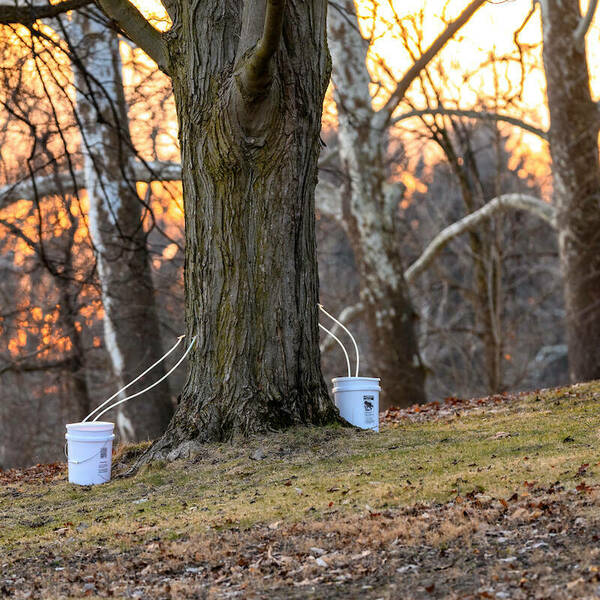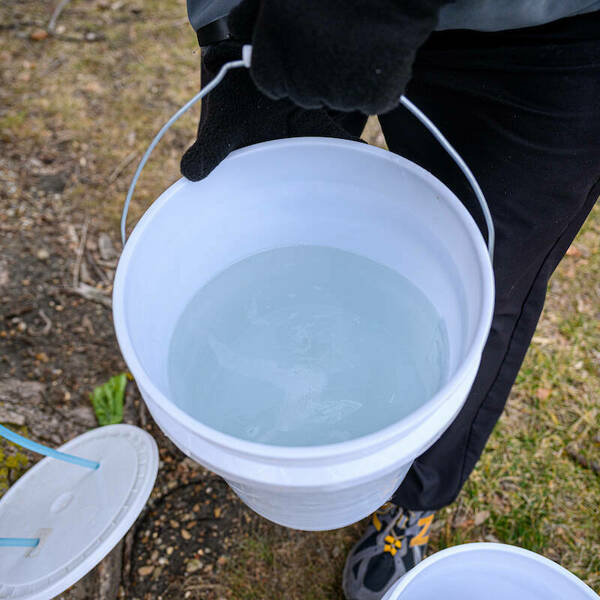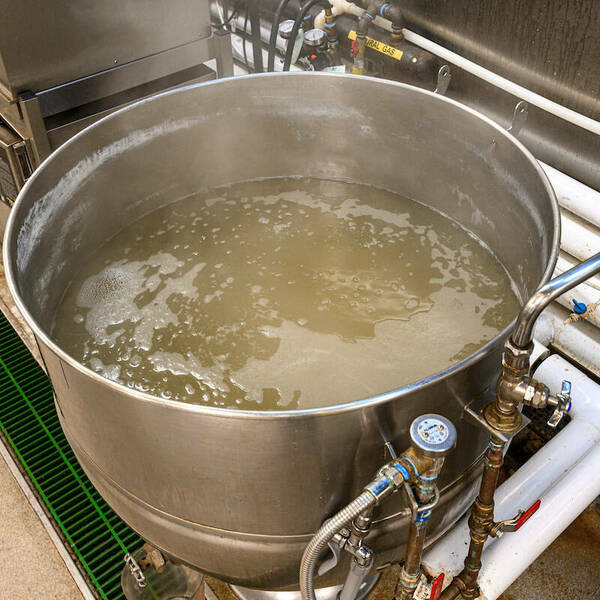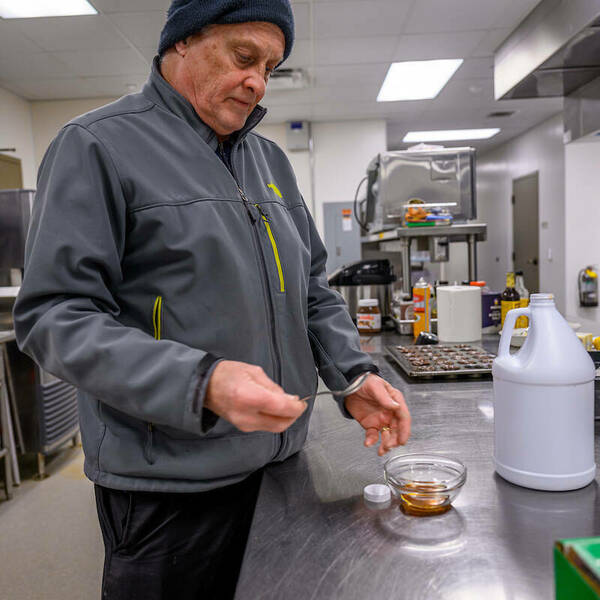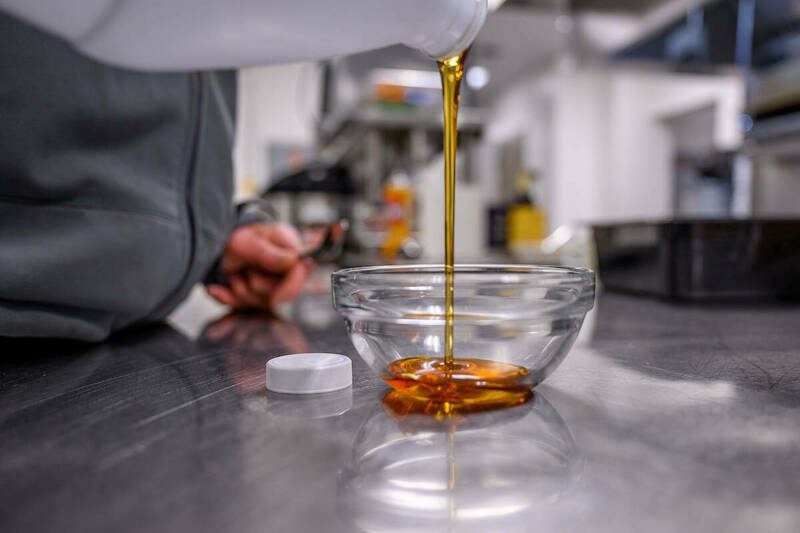 Looks just right — about 59 degrees Brix, the sweet spot for maple syrup preparation. Photography by Matt Cashore ’94
Looks just right — about 59 degrees Brix, the sweet spot for maple syrup preparation. Photography by Matt Cashore ’94
Alan Seidler, chef manager of Corby Hall, climbs into his car with a mug of coffee on a drizzly morning. He sets off along the gravel path that loops around Saint Mary’s Lake and up to the Holy Cross Annex, stopping at a group of trees with tubing attached to white buckets.
A clear liquid, sap from sugar maple trees, has collected in the buckets. Seidler dumps the sap into new buckets that he places in the back of his car, leaving the empty ones tethered to the trees to gather more.
Seidler works quickly. He has this routine down and will collect up to 100 gallons of sap today, making two or three more runs to empty the buckets as they continue to fill up.
The sap he collects will be boiled down to make sweet, amber-colored maple syrup. It isn’t an easy process. Forty gallons of sap produces just one gallon of maple syrup, and the sap must be boiled for eight to nine hours, requiring a watchful eye.
Seidler has been making maple syrup on campus for four years and he expects to produce at least 20 gallons this year. Maple sugaring season typically begins in late February or early March when temperatures are freezing at night and warmer during the day.
“When you have a good 15- to 20-degree swing in temperatures between the day and night, that’s when [the sap] really starts to flow,” Seidler says. “What happens is the tree starts drawing up sap, but then when it starts to freeze it drops it back down and that up-and-down movement past the spile is what gets it to drain.”
A spile is a sort of spigot inserted into a two-inch hole drilled into the tree. The spile taps into xylem vessels, tubes within a tree that transport water and nutrients from the roots to the leaves. The change in pressure due to temperature variations during the day and night creates a tension in the xylem that pulls the sap upward, past the spile, causing the buckets to fill with sap.
After the sap is collected, Seidler brings it to the Center for Culinary Excellence (CCE) just north of campus off Douglas Road. At the CCE, the sap goes into a 100-gallon kettle and it’s brought to a boil. A strainer skims debris, such as blades of grass, off the top of the mixture. After eight or nine hours of boiling, the syrup is ready for the final steps.
“You have to watch it real close at the end,” Seidler says as he peers over the top of the kettle at the sap that has been transformed into maple syrup in the past few hours.
He pulls out a hydrometer, a glass tube with a bulb weighted at one end, which measures the density of the syrup. The denser the syrup, he explains, the more sugar it contains. The sugar percentage of syrup is measured in degrees Brix; one degree Brix equals one percent sugar content.
Seidler points to a notch on the instrument, “When [the hydrometer] reaches this red mark we know it’s about the correct sugar content,” he says. “When there’s too much water the viscosity isn’t thick enough and it sinks to the bottom, so when it bobs up to 59, that’s what we’re looking for.” That measurement now indicates the sweet spot — 59 percent sugar content.
The final step before cooling and packaging involves filtering the hot syrup through a wool filter to remove any lingering impurities. Then it’s ready to be poured into mason jars with handmade Corby Hall maple syrup labels.
Gesturing to two jars on a shelf above his desk, Seidler says, “This is the last of last year’s maple syrup. We ran out about halfway through the football season last year, but I always save a little bit for special occasions, like the trustee’s dinner.”
The maple syrup is served at breakfast in Corby Hall and residents enjoy it on their waffles. Rev. Edward “Monk” Malloy ’63, ’67M.A., ’69M.A., the former University president, says it’s a tradition handed down for years among Corby Hall residents to make waffles after Mass on Saturdays.
The religious houses on campus, including Corby Hall, Moreau Seminary, Columba Hall and Holy Cross House, share the syrup, allowing everyone to get a taste of the liquid gold. “It never travels off campus. It never goes more than a half mile,” Seidler says. “That’s ultra-local.”
Rev. E. William Beauchamp, CSC, ’75, ’81M.Div., Notre Dame’s former executive vice president, says the origin of the syrup makes it especially enjoyable for Corby Hall residents.
“You can always go to the store and buy syrup,” he says, “but this syrup comes from the Holy Cross land here on campus, which makes it special.”
Caroline Collins, a junior environmental science major and journalism minor, is this magazine’s spring intern.
